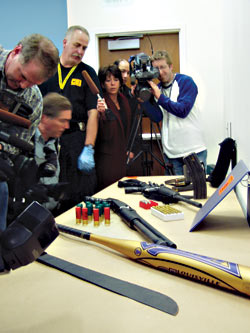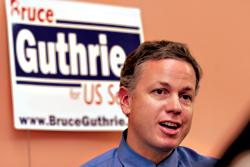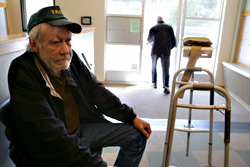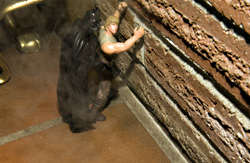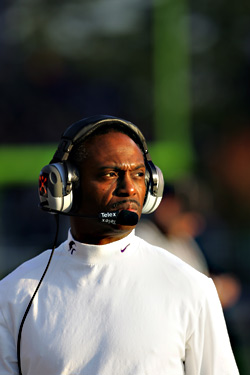You want to make sense of the executions Saturday morning, March 25, on Capitol Hill, but there’s a nagging contradiction. Kyle Aaron Huff, 28, shot eight people, killing six of them, at a tidy blue house on East Republican Street before putting a shotgun to his own head. Obviously, he was an archetypal lone freak who stockpiled weapons and ammunition, who snapped on a fundamental level, in whom none of these things could be predicted.
But Huff was also a methodical man who in recent weeks, and perhaps longer, had hung out on the local rave scene. He knew some of the people he slaughtered. Some in the multifaceted rave community say they made attempts to be kind and loving to Huff—to offer him acceptance in a world that had either tossed him aside or that he had rejected. His response was to walk out of an after-rave house party at 7 a.m., go to the black pickup he had driven, and grab a pistol, a pistol-grip shotgun, a can of red engine-block spray paint, and enough ammunition to murder far more people than six.
It’s a rough thing for some on the rave scene to process, that he’d been in their midst and rejected the acceptance and emotional openness that are hallmarks of a world of outcasts who accept outcasts. Huff wasn’t really the random loner as he’s been portrayed, invited to an after-party by people who had met him only hours before. Sources in the rave community say Huff had been hanging around dances and late-night parties in Seattle for a few weeks, maybe longer. So what happened near daybreak March 25 was carefully premeditated. It couldn’t have been random. He knew exactly what he was doing.
After retrieving the arsenal from the truck, he walked the 250 feet or so along 22nd Avenue East back toward the house at 2112 E. Republican St. Huff stopped three times to spray paint his apocalyptic and so-far-cryptic message on the sidewalk and on one home’s steps:
NOW. NOW. NOW.
At the house, Huff then blasted the same people who had been generous and kind to him. He uttered one sentence, something along the lines of, “There’s plenty for everyone!” Those who knew him as a youth profess they could not have predicted these actions. Little in his adult life would have foretold them. But there he was, a monster hunting human beings.
The rave community is driven by electronic music with roots in 1970s and 1980s dance music. It is like the punk-rock and hip-hop worlds in that there are many styles and genres of music within its boundaries. The unifying element is that the music is fun and danceable and that the environment is friendly and nonviolent. But there are subtle differences within the scene. There is spiritually based “hippie music” known as goa, and darker, angrier dance music derived from heavy metal sometimes known as psy-core, as well as upbeat poppy music dubbed happy-core. As a result, not all ravegoers attend every rave event. If the music isn’t their preferred style, they stay away, much as straight-edge punks would steer clear of a booze-soaked hardcore punk show.
Consequently, not everyone in the local rave scene interviewed for this article agrees about which events or after-parties Huff attended. But on March 11, he was seen at an after-party following an event called “Robogirls” at Studio Seven on South Horton Street, though it’s not clear if he was at the “Robogirls” event itself. People who were at the party describe him as being quiet and sitting apart. One woman said she asked Huff at one point if he was cold. He said he was, and she offered him a blanket. When he left, he took the blanket with him.
A number of people say he was either at a rave on March 17 called “Gettin’ Lucky,” held at the South Lake Union Naval Reserve Building, or at a party later that night. Several who were at the party report that Huff and one of his future shooting victims, Justin “Sushi” Schwartz, interacted. It is not known what they discussed.
Jesiah Martin, who lived at the house on East Republican and was there at the time of the shootings, said in an e-mail exchange that he didn’t think anyone had seen Huff before March 24. “Everyone I have talked to never saw him before that night,” Martin said. “I, like all my other roommates, saw him for the first time at the CHAC,” the Capitol Hill Arts Center where the fateful rave was held Friday, March 24, “then at our house, where we all had very pleasant interactions with him.”
The CHAC event is what some in the media have dubbed the zombie rave. Called “Better Off Undead,” it ran until 4 a.m. Saturday. Some news media have made it sound as though there was a zombie cult in the rave community. Ravers say that the zombie theme was no different from a toga theme the week before—an attempt by promoters to appeal to audiences with an interesting theme in a competitive dance-event market.
The most telling sign that Huff harbored a newly hatched interest in electronic dance music, however, came almost two months ago when he posted a message on a Seattle rave message board: “hey, Ive never been to a rave in seattle and was wondering if anyone could tell me when one is coming up. Its the 1st of febuary 2006 right now.”
It wasn’t until the night after the shooting that some in the local rave scene realized that Huff had been among them for weeks. “What did you need?” wonders Tabitha Stone, distraught at learning that Huff had killed some of her friends. “What was hurting you so bad? Why didn’t he ask us for what he needed? Did he need a helping hand or love? I don’t know what made him not a human being, or what was hurting him that bad.” Said another local raver who identified herself as Gaze: “Anyone can be part of our family.”
Explaining the “all freaks accepted here” aspect of rave culture, Stone says, “Maybe that person feels left out of the world. Maybe they need to be loved. We’re going to let them in.” Almost everything known about Huff consists of puzzle pieces that don’t interlock. “None of it fits together,” said Gaze.
Was Huff mentally ill, a man off his meds? Was he bent on exploding a subculture for which he’d nursed a long hatred? Or could he as easily have done his killing at a fraternity party or a church service? What was up with the word “NOW” he spray painted on his way to kill people? Who the hell walks down a sidewalk on a nice spring morning with two lethal weapons and stops to put that enigmatic stamp on concrete? Who takes the time to do that and doesn’t have a piece of sweet reason regulating the moment? “NOW”? Now is the time to kill, among others, girls ages 14 and 15?
Most of the clues point to a lone sociopath who, for whatever reason, homed in on a bunch of ravers. He had a calm demeanor, according to people at the apartment complex in North Seattle where he lived with his twin, Kane Huff. Also polite. Yes ma’am. No ma’am. Kyle Huff was calm during his forays into the rave scene, too, but calm to the point of being cold and almost nonverbal.
Kyle and Kane grew up in Whitefish, Mont. (See “Evil Twin,” p. 16.) They attended Whitefish High School. “They were somewhat outcasts that mostly kept to themselves,” recalls one classmate. “Their appearance was always a bit intimidating, as they were both big guys who were always dressed in dark clothes and trench coats. I do remember meeting them and was surprised that they were actually reserved and quiet in person. They didn’t seem threatening at all once you got past the appearance.”
Another classmate remembers Kyle Huff as “quiet and gothic.”
It’s hard to gauge how the killings will be addressed by local and state officials. But politicians being politicians, someone is bound to harness the moment. By the rules of our sociocultural physics, any action gets a reaction. But what happened on Capitol Hill was crazy— an action unto itself. It sure wasn’t a tragedy that the rave community did anything to create.
The Seattle Times on Monday, March 27, editorialized that it’s time for civic leaders to look into tightening the city’s All Ages Dance Ordinance, which regulates music events attended by minors. “I think they’ll do as much as the media demands that they do,” says Dominic Holden, a Capitol Hill resident, community activist, and friend of at least one of the victims. “To make the association between this party and someone who is deeply disturbed is sensationalistic and misleading.” It will be easy, he thinks, for uncomplicated minds to assume that raves are a precondition for mayhem. “There’s no apparent explanation for why he picked this community of people. He could’ve chosen a church.”
In a way, Huff did choose a church. For many urbanites, young or not, electronic music, punk rock, and hip-hop are a form of worship and transcendence. It’s a culture of people that is as susceptible to evil aberration as any other.
Staff writer Rick Anderson contributed to this article.
